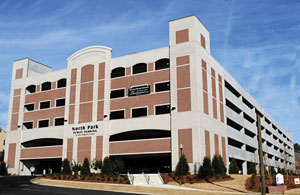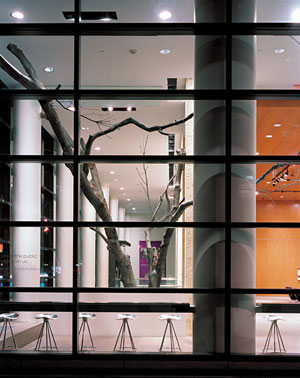The Future Looks Bright: Energy-Efficient Lighting Technologies
Letting Daylight In
| Analyzing an LED Parking Luminaire |
Energy savings are often accompanied by operational savings - and, occasionally, even first-cost reductions. All three advantages were seen when Boydston Engineering Associates of Auburn, AL, conducted an energy-use analysis for Greg Darden, development manager for Donald H. Allen Development's new North Park Parking Deck. Using Illuminating Engineering Society (IES) recommended practice RP-20, principal Alan W. Boydston, P.E., calculated that 212 metal-halide fixtures at 150 watts each and 10 metal halide standards at 250 watts would consume 38,420 watts at night and 23,870 watts during the day. An alternative LED design with 214 LED fixtures at 75 watts each, along with 20 metal-halide entrance fixtures at 150 watts each and ten 150-watt standards totaled only 17,175 watts nightly, and 13,225 watts for the daytime. These savings helped encourage the developer to choose LED for the $8 million parking deck. The long-life LEDs would also cut maintenance costs, and their unique design would reduce light trespass and control glare, making the facility safer for drivers, pedestrians and neighbors. Darden also learned that LED lighting performs well in cold winter weather, which can degrade the performance of fluorescent systems. The LED sources, rated to last more than 50,000 hours - compared to 10,000 to 24,000 hours for comparable HID sources - also came with five-year warranties. On top of that, the reduced energy loads allowed Darden to downsize electrical distribution and backup generators. "I carefully considered fluorescent technology, which is getting a lot of attention now, and the industry standard is metal halide," he recalls. "But for a lot of reasons we went with LED, which offered a very promising cost-benefit curve." Other green features of the 920-space hybrid precast and poured-in-place concrete deck include twin high-speed elevators, recharging stations for electric cars, covered bicycle parking, and an extensive digital security system. 
Photo: Kim Lighting
|
The sun is a plentiful natural resource, bringing with it abundant energy and light along with myriad health benefits. "Most projects, even basic tenant fit-outs, can benefit from utilizing natural lighting whenever possible instead of artificial sources," says Perkins+Will's Blumenfeld. A successful daylighting strategy can improve a building's life-cycle cost, reduce emissions and operating costs, and increase user productivity and satisfaction.
This last point is not conjecture. "Research has found that daylight is the 100 percent healthy package," says Simeonova. "Facts such as a 70 percent increase in work environment satisfaction and a 64 percent increase in work performance have been published by the Lighting Research Center, the National Institute of Building Sciences, and the Heschong Mahone Group. In hospitals, lighting and daylight in general are linked to overall health and faster patient recovery, as published by the Center for Health Design and the Robert Wood Johnson Foundation."
For new buildings, spaces to be sunlit can benefit from layouts that increase the structure's perimeter to maximize the usable daylighting area. To penetrate deeper into a space, clerestory windows and skylights are effective and also reduce the probability of disproportionate brightness. The design should also increase room brightness versus window brightness, for example through the use of light shelves, according to Southern California Edison's Gregg D. Ander, FAIA. Unintended side effects of daylighting, such as veiling reflections, glare and sharp contrasts, should be avoided.
While many lighting designs can be addressed through computer modeling, "There appears to be no software program or tool to help a designer who is not a mechanical engineer to understand both the lighting and energy impact of fenestration decisions," says Richard Keleher, founding co-chair of the Boston Building Enclosure Council. "While some programs exist, they are not benchmarked to U.S. standards." This is unfortunate, because the design team faces many challenges, solar heat gain chief among them.
Sources: Something Old, Something New
Another challenge of daylighting is variable light quality, which can be addressed with proper selection of electric light sources and fixtures. In this arena, significant advances from the U.S. lighting industry are helping to push energy-efficiency levels. According to many lighting designers and engineers, many of those developments are decades old, with established track records.
"Ceramic metal halide is one of the most promising," says Gary Gordon, IES Fellow and principal of Gary Gordon Lighting, New York City, referring to a source that has been on the market for at least 15 years. "It's a mix of two older technologies from the 1960s, quartz metal halide and high-pressure sodium, which together offer excellent color rendering for low-energy uses."
 |
The Jewish Community Center on the Upper West Side in NYC, designed by Diamond and Schmitt Architects with the lighting designer Gary Gordon, features a range of energy-efficient lighting fixtures and lamps. Photo: Gary Gordon Lighting |
A second source to consider, says Gordon, is halogen infrared, also known as halogen IR. "Many people are still using the same incandescent bulb that Edison deigned, and halogen IR is a drop-in replacement for existing fixtures that can slash energy use by one-third," he explains. A 60-watt halogen IR lamp, for example, yields the same amount of light as a 90-watt incandescent.
In addition, the Energy Center of Wisconsin's Schuetter notes that T8 fluorescent lamps are a workhorse of low-energy commercial lighting systems and will remain so for the foreseeable future. Yet the DOE estimates that of all 4-foot fluorescent fixtures and lamps sold in the United States last year, close to 50 percent were 1.5-inch-diameter T12s, which use more power.
"People are buying the older, less efficient technology!" exclaims DOE's Jim Brodrick, who oversees 71 research projects with a budget of $150 million in the Building Technologies Program.
"You can save a good dose of energy by moving toward efficient T8s, with a whole new generation of ballasts." An F32T8 lamp, for example, consumes 19 watts less than the typical F34T12, which is typically rated for 44 watts - a savings of about 43 percent. (See chart below.)
Ballasts, needed to regulate the flow of energy through highintensity discharge (HID ) and fluorescent lamps, also consume wattage. Ballast factor (BF), also called relative light output (RLO), compares the lumens emitted from a ballasted lamp to the light output of the same lamp on a reference ballast at rated current and voltage. Ballast efficacy factor (BEF) - the ratio of the BF to input watts - describes the efficiency of the lamp/ballast system.
The most efficient ballasts are electronic, yet even those with the highest BEF use more power than drivers, which convert AC line voltage to DC for such lighting sources as LED and induction systems.
"LED and induction lighting systems bring other advantages over traditional HID sources," says April Ruedaflores, marketing manager with Kim Lighting, City of Industry, CA. "They're not just energy efficient, but both are rated for 100,000 hours life. And unlike HID lamps that are not instant-on sources, if power fails and a backup generator ignites, these fixtures will not skip a beat - no restrike delay. Also, LED systems hold their color temperature and other characteristics when dimmed, as opposed to many traditional sources that experience color shift."
LEDs have no mercury or lead, which are common in other lamp types. Another benefit, adds Ruedaflores, is that LED lighting systems are compatible with voltages from renewable energy systems. That means facilities can more easily go "off the grid" and use only energy produced on site by photovoltaic systems and the like.
|
|||||||||||||||||||||||









